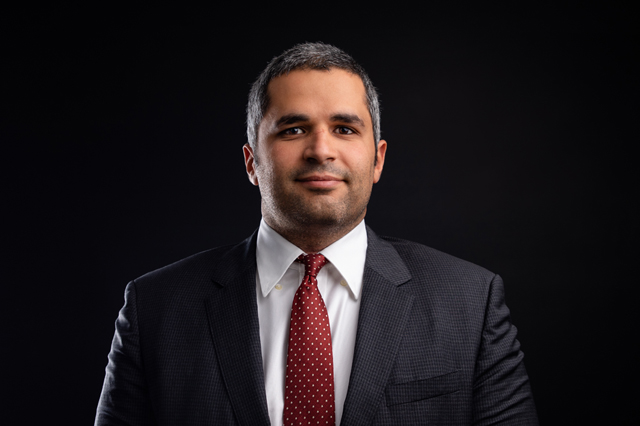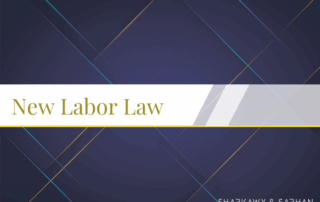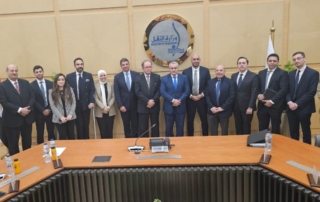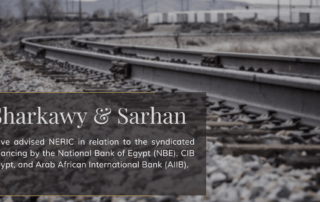27th of February, 2017
Sharkawy & Sarhan Advises Nestle in its Acquisition of Caravan
By: Ahmed Haggag, Esraa Abdelmoniem and Noha Eissa
Keywords: Mergers & Acquisitions, Banking & Finance
Sharkawy & Sarhan Advises Nestle in its Acquisition of Caravan
and while we are at it, read our 5 must-haves for handling a successful M&A transaction.
Sharkawy & Sarhan Law Firm acted as legal adviser to Nestle in relation to Nestlé’s acquisition of Caravan Marketing Company SAE (“CMC”), a leading Egyptian instant coffee company owner of the Bonjorno brand. The deal represents another commitment by Nestle to invest in Egypt (see the press release here).
The Sharkawy & Sarhan team advising Nestle on this transaction was comprised of Partner Ahmed Haggag, Associates Reham Eissa and Esraa Abd Elmoniem, and Attorneys At Law Yomna Elewa and Mohamed Rasekh.
Partner Ahmed Haggag and Associate Esraa Abd Elmoneim (far right) attending the signing of the documentation
We are optimistic about the prospects of M&As in Egypt in 2017. The Nestle acquisition is a testament of the expected M&A activity yet to come.
Sharkawy & Sarhan has a strong M&A practice and has had a busy year in 2016. This transaction is Sharkawy & Sarhan’s fourth major M&A deal in 2016, following S&S’s work on the Egyptian law aspects of the acquisition by Altijariwafa Bank of Barclays Bank Egypt; Eni’s sale of its stakes in Egypt’s giant Zohr Gas Field; and Al-Abbar’s Adeptio $2.36 Billion Acquisition of Americana.
With our practice spanning several industries and sectors, we have come to hold into five main pillars that inform our ethos in our M&A work. We share them below.
S&S’ 5 ethos for delivering in M&A transactions:
1. Know your business sector.
Each business sector has its own set of regulations governing M&A. For example, Banking M&As have very strict requirements for the acquisition process, while Fast-moving consumer goods (FMCGs), in comparison, have more lenient requirements. Understanding the business sector will help in (a) determining the compliance requirements/procedures, (b) assessing the timeline, (c) identifying red flags and (d) managing the expectations of the client.
2. Understand the client’s acquisition objectives.
Each client is seeking different objectives from an M&A. Some clients would be looking for a long-term investment. Others would look for a market share. Knowing the client’s objectives will guide the due diligence process and lead to identifying the issues that are most relevant to the client.
3. Differentiate between the must-haves and the good-to-haves.
Identifying this at an early stage should lead to a smoother negotiation process.
4. Tailor the transaction documents to manage the specific commercial and legal concerns.
Templates usually help as a starting point but transaction documents are not a one size fits all.
5. Be wise in the critical moments.
M&A transactions involve several parties. Each party has its own perspective and objective. Appreciating the difference in critical moments (for example, during the finalization of the due diligence process, or during closing), guarantees a professional and smooth acquisition.
Partner Ahmed Haggag and Associate Esraa Abd Elmoneim (far right) attending the signing of the documentation
We are optimistic about the prospects of M&As in Egypt in 2017. The Nestle acquisition is a testament of the expected M&A activity yet to come.
Sharkawy & Sarhan has a strong M&A practice and has had a busy year in 2016. This transaction is Sharkawy & Sarhan’s fourth major M&A deal in 2016, following S&S’s work on the Egyptian law aspects of the acquisition by Altijariwafa Bank of Barclays Bank Egypt; Eni’s sale of its stakes in Egypt’s giant Zohr Gas Field; and Al-Abbar’s Adeptio $2.36 Billion Acquisition of Americana.
With our practice spanning several industries and sectors, we have come to hold into five main pillars that inform our ethos in our M&A work. We share them below.
S&S’ 5 ethos for delivering in M&A transactions:
1. Know your business sector.
Each business sector has its own set of regulations governing M&A. For example, Banking M&As have very strict requirements for the acquisition process, while Fast-moving consumer goods (FMCGs), in comparison, have more lenient requirements. Understanding the business sector will help in (a) determining the compliance requirements/procedures, (b) assessing the timeline, (c) identifying red flags and (d) managing the expectations of the client.
2. Understand the client’s acquisition objectives.
Each client is seeking different objectives from an M&A. Some clients would be looking for a long-term investment. Others would look for a market share. Knowing the client’s objectives will guide the due diligence process and lead to identifying the issues that are most relevant to the client.
3. Differentiate between the must-haves and the good-to-haves.
Identifying this at an early stage should lead to a smoother negotiation process.
4. Tailor the transaction documents to manage the specific commercial and legal concerns.
Templates usually help as a starting point but transaction documents are not a one size fits all.
5. Be wise in the critical moments.
M&A transactions involve several parties. Each party has its own perspective and objective. Appreciating the difference in critical moments (for example, during the finalization of the due diligence process, or during closing), guarantees a professional and smooth acquisition.
Sharkawy & Sarhan Advises Nestle in its Acquisition of Caravan
27th of February, 2017
By: Ahmed Haggag, Esraa Abdelmoniem and Noha Eissa
Keywords: Mergers & Acquisitions, Banking & Finance
Sharkawy & Sarhan Advises Nestle in its Acquisition of Caravan
and while we are at it, read our 5 must-haves for handling a successful M&A transaction.
Sharkawy & Sarhan Law Firm acted as legal adviser to Nestle in relation to Nestlé’s acquisition of Caravan Marketing Company SAE (“CMC”), a leading Egyptian instant coffee company owner of the Bonjorno brand. The deal represents another commitment by Nestle to invest in Egypt (see the press release here).
The Sharkawy & Sarhan team advising Nestle on this transaction was comprised of Partner Ahmed Haggag, Associates Reham Eissa and Esraa Abd Elmoniem, and Attorneys At Law Yomna Elewa and Mohamed Rasekh.
Partner Ahmed Haggag and Associate Esraa Abd Elmoneim (far right) attending the signing of the documentation
We are optimistic about the prospects of M&As in Egypt in 2017. The Nestle acquisition is a testament of the expected M&A activity yet to come.
Sharkawy & Sarhan has a strong M&A practice and has had a busy year in 2016. This transaction is Sharkawy & Sarhan’s fourth major M&A deal in 2016, following S&S’s work on the Egyptian law aspects of the acquisition by Altijariwafa Bank of Barclays Bank Egypt; Eni’s sale of its stakes in Egypt’s giant Zohr Gas Field; and Al-Abbar’s Adeptio $2.36 Billion Acquisition of Americana.
With our practice spanning several industries and sectors, we have come to hold into five main pillars that inform our ethos in our M&A work. We share them below.
S&S’ 5 ethos for delivering in M&A transactions:
1. Know your business sector.
Each business sector has its own set of regulations governing M&A. For example, Banking M&As have very strict requirements for the acquisition process, while Fast-moving consumer goods (FMCGs), in comparison, have more lenient requirements. Understanding the business sector will help in (a) determining the compliance requirements/procedures, (b) assessing the timeline, (c) identifying red flags and (d) managing the expectations of the client.
2. Understand the client’s acquisition objectives.
Each client is seeking different objectives from an M&A. Some clients would be looking for a long-term investment. Others would look for a market share. Knowing the client’s objectives will guide the due diligence process and lead to identifying the issues that are most relevant to the client.
3. Differentiate between the must-haves and the good-to-haves.
Identifying this at an early stage should lead to a smoother negotiation process.
4. Tailor the transaction documents to manage the specific commercial and legal concerns.
Templates usually help as a starting point but transaction documents are not a one size fits all.
5. Be wise in the critical moments.
M&A transactions involve several parties. Each party has its own perspective and objective. Appreciating the difference in critical moments (for example, during the finalization of the due diligence process, or during closing), guarantees a professional and smooth acquisition.
Partner Ahmed Haggag and Associate Esraa Abd Elmoneim (far right) attending the signing of the documentation
We are optimistic about the prospects of M&As in Egypt in 2017. The Nestle acquisition is a testament of the expected M&A activity yet to come.
Sharkawy & Sarhan has a strong M&A practice and has had a busy year in 2016. This transaction is Sharkawy & Sarhan’s fourth major M&A deal in 2016, following S&S’s work on the Egyptian law aspects of the acquisition by Altijariwafa Bank of Barclays Bank Egypt; Eni’s sale of its stakes in Egypt’s giant Zohr Gas Field; and Al-Abbar’s Adeptio $2.36 Billion Acquisition of Americana.
With our practice spanning several industries and sectors, we have come to hold into five main pillars that inform our ethos in our M&A work. We share them below.
S&S’ 5 ethos for delivering in M&A transactions:
1. Know your business sector.
Each business sector has its own set of regulations governing M&A. For example, Banking M&As have very strict requirements for the acquisition process, while Fast-moving consumer goods (FMCGs), in comparison, have more lenient requirements. Understanding the business sector will help in (a) determining the compliance requirements/procedures, (b) assessing the timeline, (c) identifying red flags and (d) managing the expectations of the client.
2. Understand the client’s acquisition objectives.
Each client is seeking different objectives from an M&A. Some clients would be looking for a long-term investment. Others would look for a market share. Knowing the client’s objectives will guide the due diligence process and lead to identifying the issues that are most relevant to the client.
3. Differentiate between the must-haves and the good-to-haves.
Identifying this at an early stage should lead to a smoother negotiation process.
4. Tailor the transaction documents to manage the specific commercial and legal concerns.
Templates usually help as a starting point but transaction documents are not a one size fits all.
5. Be wise in the critical moments.
M&A transactions involve several parties. Each party has its own perspective and objective. Appreciating the difference in critical moments (for example, during the finalization of the due diligence process, or during closing), guarantees a professional and smooth acquisition.
Insights
Disclaimer
The information included in this publication/client alert is not legal advice or any other advice. Publications and client alerts on this site are current as of their date of publication and do not necessarily reflect the present law or regulations. Please feel free to contact us should you need any legal advice related to the publication/client alert. Sharkawy & Sarhan (the “Firm”) will not be held liable for any compensatory, special, direct, incidental, indirect, or consequential damages, exemplary damages or any damages whatsoever arising out of or in connection with the use of the data, information or material included in this publication/client alert. This publication/client alert may contain links to third-party websites that are not controlled by the Firm. These third-party links are made available to you as a convenience and you agree to use these links at your own risk. Please be aware that the Firm is not responsible for the content or services offered by and of third-party websites, links as included in the Newsletter nor are we responsible for the privacy policy or practices of third-party websites links included therein.
Authorization of Use
The data, information, and material included in this publication/client alert are solely owned by the Firm. All rights related are reserved under the laws of the Arab Republic of Egypt. No part of this publication/client alert can be redistributed, copied, or reproduced without the prior written consent of the Firm.





